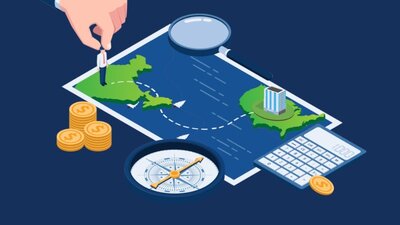Avlesh: “But what people don’t understand very well is pivoting products, of course, is hard. But what is harder is actually pivoting the entire engine below it. So your sales, your marketing, your documentation, and your support need to pivot. Forget everything, your customer service needs to prove it. All of these things make the pivot incredibly hard.”
Avlesh Singh is the co-founder and CEO of WebEngage, a Blume Fund I company. In more than a decade of running WebEngage, Avlesh has seen it all, from hard pivots to working with salespeople in the trenches to selling internationally. This has enabled WebEngage to grow in a highly competitive Martech market, where the market map looks like the popular Spiderman meme, with every company positioned as a 'customer engagement' company.
My conversation with Avlesh is in two parts. In part 1, I cover what he learned when he pivoted WebEngage. If you have recently pivoted or considered a pivot, this is a must-read section for you. In part 2, I share his insights on Customer Success, pricing, selling to mid-market vs. enterprise, and the importance of positioning. I hope you enjoy reading this and find Avlesh’s insights useful for your business.
Part 1: Hard things about hard pivots
What founders believe a pivot looks like…
Avlesh shares that most founders believe pivot to be a product problem - they will make some changes to their product or launch a completely new product to capture a new, larger market. So they spend their time with the product and engineering teams to ensure the new product meets the feature stack of the new market.
Avelsh: “Many times, founders think of pivots as a product pivot. And that’s how it starts. For software companies like us, that’s how it starts. You’ll feel that the current product is catering to the audience in a certain way, to which the customer has ascribed a certain value. If you really want to change the value to something higher, then you have to change the product; you have to deliver more value. It doesn’t happen with small changes. You have to do something major. That phenomenon is largely a pivot.
…versus what it actually looks like
Avlesh: “But what people don’t understand very well is pivoting products, of course, is hard. But what is harder is actually pivoting the entire engine below it. So your sales, your marketing, your documentation, and your support need to pivot. Forget everything, your customer service needs to prove it. All of these things make the pivot incredibly hard.”
It is important to understand why Avlesh says, ‘all of these things make the pivot incredibly hard.’ Once you have spent enough time in a phase of your company’s journey, your org is set in its ways - salespeople are used to the sales pitch, marketing is used to the messaging, and customer service knows about the types of customer issues. When you pivot, you ask all of them (and many more in your company) to leave their comfort zone and enter a zone of uncertainty. In fact, Avlesh believes that it’s easier to build a new product as you start from a clean slate than to pivot an existing one.
What makes a pivot hard is that many founders underestimate the pain and time required to transition their entire org and aren’t mentally prepared to deal with it. Once the product is pivoted, many of them emphatically chase new customers without zooming out and checking if the organization is ready.
Avlesh: “Pivoting everything below the product is a lot harder, and that’s what people underestimate so much, including people like me, we go through that journey. I'd probably be a little smarter if I had to do it all over again. But everybody makes that mistake.”
“It takes much longer for your teams to pivot than for your product to pivot. And a lot of that is just the lack of preparation. It’s not hard. You don’t foresee a lot of things. And then, of course, there are a lot of unknowns. What is the new customer persona going to be? Because you’re still discovering? What is the new pricing going to be?”
“We just get busy in the daily grind, and we try to hustle our way through what we have, not realizing that a lot of what we have also needs to pivot in terms of teams, processes, culture, documentation, something as simple as that.”
Here are some real-life examples from Avlesh on how different parts of the organization change during a pivot:
Product
Avlesh: “In my case, we had almost an integration-free product in our last avatar; there was zero integration. And now I spent six to eight weeks just to integrate it, eight weeks! In some cases, I’ve spent six months just to get the product to work. So it’s a very different beast.”
Sales
Avlesh: “A person who sells a $3k product cannot sell a $30k-$40k product, no matter how smart the guy is. It’s a growing-up challenge. Some will grow, many won’t. The DNA that guy needs to go in to have a $40k conversation is very different from the guy selling a $3k product versus someone selling at $100k.”
Customer Success
Avlesh: “Back then, we had no difference between a Customer Success guy and an onboarding guy. So, when I pivoted, I told my Customer Success guy, hey, here’s the customer. Now get him set up for using the product. But think about it, how will he start? He doesn’t know what an SDK is. He doesn’t know what a data model is. He doesn’t know anything about integration. We gave him four documents and trained him in a training session, and we expected him to start asap. It will not work. He doesn’t know how to do it.”
Post-pivot, go back to founder-led customer discovery and sales, handhold your sales team through uncertain times, and ensure the new brand story percolates across the sales team.
Don’t assume PMF post-pivot and rush to sell your new product. Instead, go through customer discovery and build the brand story again, with the founder being the key salesperson. Ensure that your sales team/leaders are shadowing you for the knowledge to percolate across the sales org, and you can scale selling later.
Avlesh: “And I made sure that we are not unleashing the sales engine until we figured out the crux of what it is. So working on very few named prospects, one with each of my sales guys, with me leading the conversation to develop what the pitch should ideally look like. I didn’t know how or what it would look like, but at least, by leading, I was getting first-hand clarity on where we must go. 10-12 of these conversations during the first six months, nothing more.
“In that cycle, the sales guys grow with you. They become a part of the customer discovery cycle, not the sales cycle, which is very important because then they understand the psyche on the other side. Some of those things are much harder than the sales pitch itself. So yes, that’s how sort of I led that, which was essentially all founder-led sales. Flipkart was my largest customer at that time. I remember leading my sales team there to make them understand why they would find value in paying us more for something like this and sensitize them to the new reality. They saw the whole cycle, from end-to-end, from pitches to the kind of collateral you need to build into the process to the final pricing models.”
“And, once everyone goes from that cycle, then you can build sales in general, so I did spend like a good, I think, 6 to 12 months, just getting this right. After that, we haven’t looked back.”
As a founder, you’ll need to handhold your sales team through the pivot’s uncertainty, which may include being soft on their variable payout and helping them finetune the sales narrative from selling a $3k product to a $30k product. Post the pivot, your salespeople will often struggle to sell the new product, which can demotivate them and spiral out of control rapidly.
Avlesh: “Most salespeople cannot live with uncertainty. For them, that’s the hardest thing to do. And suppose they cannot sell due to being uncertain about the product. In that case, they develop very deep insecurities within, doubting themselves, doubting the product, doubting the company, it happens very quickly, spirals very quickly.”
“I think you have to orchestrate that change phase to something as simple as everybody gets 100% of the variables until we figure this out and so on. I’m just anecdotally saying 100%. It may not be 100%. But you have to think of it as these guys growing in the cycle of helping build that sales pitch that doesn’t look like a $3k product. It looks like a $30k product. And how a $30k product pitch looks like itself is a journey.”
Even after doing all this, don’t assume that things will be easy because, unlike an early-stage company undergoing customer discovery, you’ll have many more people on payroll and burn through cash to keep the company afloat.
Avlesh: “And it was a very difficult time because we didn’t have the money. We still have to keep people on the payroll, pay them the full compensation, etc. But again, as I said, I wouldn’t go back and change any of that.”
If you are enjoying this article, you can join our mailing list to get all articles from Blume into your inbox every month.
Part 2 - Insights on Customer Success, pricing leading to product, selling to enterprise, and the importance of having a shart positioning
Consider onboarding and Customer Success as two stages in the customer journey, separate the teams, and assign them different KRAs to set up your customers for success.
If your product has a complex onboarding process with data migration, integrations with other tools, and adding SDK/code snippets to the customer’s app/portal, Avlesh suggests you should carve out the Onboarding team from the Customer Success team and keep them separate with different KRAs. It is possible that while you have a DIY product right now, as you evolve, the onboarding complexity increases. Founders should watch out for it and separate the Onboarding and Customer Success teams at the right time.
Avlesh: “Those who see Onboarding and Customer Success teams as one will be very similar to my previous product’s journey, where there were no integrations. Those are low-touch DIY products where the customer support team exists so customers can talk to someone if they face any issues. There’s no real value add from the Customer Success team in setting up the customer for success.”
So how should you staff the Onboarding team, and what is their KRA?
Avlesh: “We have a 30-people Onboarding team now, a very solid function. They have only one job. When we give them a customer, they have to onboard customers, and onboarding has many stages. So there are all these nice checklists: Step one, step two... What will WebEngage do? What is expected from the customer? How do we check Data Model, Data Sanity? It’s a whole process.”
“Because that function is a lot closer to data models and engineering than it is to Customer Success, most of my onboarding guys will come from engineering backgrounds and will have data and data analysis as their key skills.”
The profile and the KRAs of the Customer Success team at WebEngage are very different from the onboarding team.
Avlesh: “The Customer Success guys in my company play the role of a consultant. A lot more planning and strategy-driven, rather than tactics. The value that I deliver to my customer through the Customer Success guy is helping them strategize better, helping them execute better, so that they can get their ROI within the first six months of deployment. And continue to grow beyond that.”
“Some will also be project managers, but most of my Customer Success guys will be solution consultants and product consultants who know how best to use WebEngage. If you’re a fintech company, what five things do you need to consider on day one? Five user journeys that you need on day one, and so on. So that’s the skill set that’s required.”
It’s not only about separating the onboarding team from the Customer Success team as your product’s complexity increases. The KRAs of the Customer Success team should also evolve from being reactive (solving customers’ problems when they reach out) to proactive (guiding customers using best practices and driving ROI from WebEngage for them) as your product evolves.
Avlesh: “Earlier, we had a Customer Success team that was very small. Everything that happened after the sale was a Customer Success person’s responsibility. And because the product was so low touch, it practically didn’t need anyone. We wanted to give some cushion to the customers, so we had a few people, but there was no practical advantage of having those Customer Success people. I don’t think the customer was deriving any value from that person except when the product is not working, and they want to talk to someone.”
“Now, the product changed, which means the Customer Success involvement is very high touch. Now our Customer Success team has 100 people. Very, very high touch. They look into where the campaigns are heading. Which segments are working, and which ones are not working? Much of this is just planning, ideating with the customer to figure out what to do. My Customer Success guys have a window to a lot more data, so they come across as smart and can provide more insights than what the customer knows in their context. If you are a D2C or an ecommerce brand, as a Customer Success person, I have a window to 50 different campaigns, and I can tell you what works and what doesn’t, how to make your campaigns better, etc.”
To position yourself sharply in a crowded market, put effort into finding who are your core competitor cohorts across different customer segments.
Here’s a real market map of the Martech tools ecosystem, with each of those small dots being the logo of a Martech company. It’s a very competitive and highly crowded market, to say the least. On top of that, companies have features that cut across segments, and some companies will stuff their websites with jargon, making it difficult for customers to distinguish between them.
Avlesh: “We’re in a very competitive landscape; anything martech is just crowded. It’s funny because marketing tech is very deep; it has many nuances and variants. These companies give you customer engagement, customer support, chatbot, etc. The competition revolves around the jargon. If I say, let’s find customer engagement tools, you would find so many people with no customer engagement features in their product but will still use customer engagement as their core pitch. Because of those reasons, it’s a very difficult space for customers to navigate. The competition also changes from India to the US to the Middle East or mid-market to enterprise.
Here’s an interesting point - your ability to differentiate from other companies diminishes as you scale beyond early adopters.
Avlesh: “Early wins are okay. They are evolved customers, much more informed, sharper, etc. But as you scale, more problems develop, and you will get many people who aren’t fully informed about the market. They have a problem distinguishing one tool from another.”
How do you differentiate yourself in a crazy crowded market? Avlesh shares two tips: (a) Have a deep understanding of your core customers and their pain points (b) Cut out all the noise to zoom into the right cohort of competitors. Use these two to build unique messaging for your product.
Avlesh: “So finding the right competition cohort is very important, but it’s very difficult because the moment you zoom into a different customer segment, the whole competition changes. In the consumer tech segment in India, our competition is, say CleverTap or MoEngage. But my competition in the Middle East is an Insider in the same category. However, when I zoom into the enterprise customer, we sell to Unilever, Adani, Eureka Forbes, IKEA, etc., it’s a whole different world. The competition here is Adobe Marketing Cloud, Salesforce Marketing Cloud, and Oracle Marketing Cloud.”
“Who is my competition? It's a very important question to answer, but founders don’t put effort into that. I think the other thing we do very well, and we have been very good at it, is having a very deep understanding of who my real customer is and their real pain. Who is my real competition? What are its real advantages and real drawbacks? We focused very much on those things.”
Let the price you want to charge lead to the product you want to sell, there are only two pitches to sell SaaS products in India, and don’t expect an immediate ROI with a premium product.
Avlesh wanted to sell WebEngage as a product with premium features and charge premium pricing.
Avlesh: “We sell for a premium in our category. In our category in India or the Middle East, wherever we operate, we always sell for a premium. So we’re not pegged at what the competition is pricing. We always sell at a premium. And we harp on our capabilities.”
He also strongly believes that there are only two ways to sell a SaaS product in India - it makes money for your customers or helps them save money.
Avlesh: “Pricing is a very difficult topic for most founders, including us, but the one framework we always used throughout our journey is to look at it with a slightly different lens, and I have a very strong thesis about it. There are two kinds of products that sell. One is a product that generates revenue for you. Another product is the one that saves your cost. Everything else is very difficult to sell. It’s not like no product in any other category, but they are hard to sell. When you tell someone, “It will save you time.” He can say, “It will save time, but how will it help me? I already have many people. Time urgency that doesn’t translate to cost or revenue doesn’t create a pitch.”
For WebEngage, this desire to sell at a premium leads to a product with premium capabilities (and not vice versa), which indexes on ‘helping customers make more money’ as that’s the surest way to demonstrate value to your customer.
Avlesh: “If you can say I generated Rs one crore (INR 10M) for you, if you can claim that, then pricing is easy. Many people can’t say that. We are the first product where you can see the revenue on the dashboard as the first thing when you log in. Other tools show campaigns, how many campaigns are open, etc. We say 50 campaigns are running, and they generated Rs 50 lac (INR 5M), and this is the break-up. Emails generated this, WhatsApp generated this, and so on. That created this positioning for us that this tool generates money. It’s not like others don’t do it, but that first-mover notion is very important for you to win that war. So the way we look at ourselves is that we are a money-making business.”
However, selling a top-end product at premium pricing also comes with its own challenges of educating customers and being patient with their evolution. Founders should not expect immediate ROI even if they’ve built top-of-the-line features.
Avlesh: “The hardest part about this is, what we think our premium capabilities are, customers can’t reach there immediately. They have to evolve for them to see those things. I mean, I can try showing as much, but if it’s not their pain, they will not care about it. So it is incredibly hard for me to ask for a premium from a guy using the product at level zero in terms of their own skill set and the product’s features. Building the ROI takes a fair bit of effort and growing up. Some teams need almost a year to evolve to the premium features. They take time in building their skills.”
When moving upmarket, non-visible stakeholders influence your deal’s success, land and expand look very different for mid-market vs. enterprise, and learn to co-exist with other tools in the enterprise segment.
One of the biggest challenges that founders are often unaware of when moving upmarket, from SMB/mid-market to enterprise, is that stakeholders beyond the end-user and the economic buyer influence the buying decision significantly in the enterprise sales cycle. You may not even be able to get facetime with them, or they may not ever use your product, but they can sway any deal.
Avlesh: “Just the fact that you don’t sell it to a person anymore. You’re basically selling to people that you don’t even know. They don’t even appear in the sales cycle; they just orchestrate the process. The CIO, for example, in large organizations, while they are not end-users of many tools, they have a deep influence on what gets bought. And you have to sell to that guy without even that guy willing to have a meeting with you. And without that guy being a party to your tool, they will never use the tool.”
“In mid-market, this challenge is not as much aggravated, you largely have to stick to the VP marketing or the CMO persona most of the time, and if you do a decent job, then that deal goes through, you don’t have to navigate much for $20,000-$30,000 product sale, but the moment you get into this $100,000 range, which is where we aspire to go. It’s a very different battle; much longer sales cycles, where it takes you four to five months to put a foot in the door.”
Revenue expansion in the mid-market is indexed on customer growth. If your customer is not growing, you’ll be stuck with slow growth. However, when selling to enterprises, you can expand on more vectors.
Avlesh: “In enterprise, I sell to one business unit. Next year, I can sell to another. For instance, if Unilever uses WebEngage in Vietnam, they can use it in Malaysia next time. If it works, then they use it in Brazil. So all that expansion happens in the enterprise segment. And it is very different compared to mid-market because these opportunities don’t exist. So my growth in the mid-market is largely linked to customer growth. If they don’t grow more, I can’t expand.”
Another difference in selling to mid-market vs. enterprise is that enterprise customers have more windows of opportunity, with multiple teams having the budget to buy a new tool to solve their pain points, and you can co-exist with other tools.
Avlesh: “In enterprise, we coexist. There are many tools in an enterprise because, to them, tools are not a problem statement. They want different tools to solve problems, and we learn to co-exist with different tools in their stack. Mid-market guys can’t afford for two tools to coexist. So it’s always a replacement business in the case of mid-market. It limits my ability to grow as much as I could in the enterprise.”








